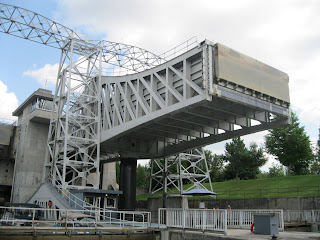This is the Peterbough lift lock, it is lock #21 and will raise the boat 65 feet. This lock was completed in 1904. Each of the 2 pans weigh 1300 tons when filled. One is lower for upbound traffic and the other is upper for downbound traffic. In the upbound travel, we entered the tray, secured the boat, and waited for other boats to secure in the lower and upper trays. At this time there is equal amounts of water in each tray upper and lower. After gates are closed, an additional 1 foot of water is added to the upper bucket (each tray has a 7 foot diameter piston under the tray). The cross-0ver valve is opened and the upper bucket starts down and the piston on the lower bucket is pushed up. Once you arrive at the top, you simply untie and continue your travel.




This is the Kirkfield lock, it is lock #36 on the Trent Severn waterway system. We were lowered 49 feet. This is a simple hydraulic system, but very impressive. There are two rectangular pans or buckets of water each with a 7 foot diameter piston. When being lowered, you drive your boat into the upper pan and secure the boat, gate closes, and an additional 1 foot of water is added to the pan in the up position. The boats in the upper pan are lowered and the boats in the lower pan are raised. As you can see, this is raising us over a roadway. We spent the night on the wall at the lower side of this lock.




This lock is called Big Shute, it is lock #44 on the Trent Severn Waterway. It is a rail system within the Trent Severn that lowers your boat 57 feet. You position the boat onto an underwater platform that has lifting straps under your boat. The straps are lifted to stablized your boat. Once all boats are secured (two others and ours) the rail plaltform moves out of the water, over a highway, and starts down the side of the hill. You arrive at the bottom, the platform continues underwater, the lifting straps are lowered and you drive off the platform into the small lake below.



No comments:
Post a Comment